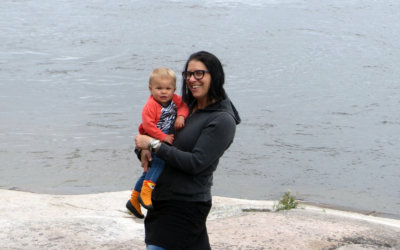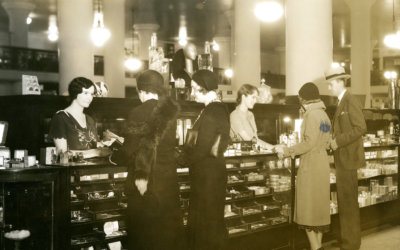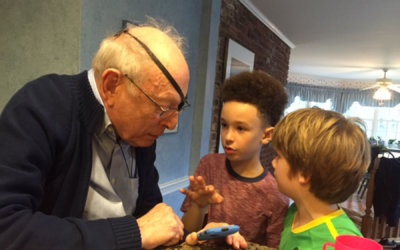A prolific conceptual artist, writer, and activist, John Sims ’90 has been working at the center of an art, activism, and global social justice practice. His work is shaped by mathematics, design, performance, film, music, the politics and symbols of white supremacy, and poetic/political text. Over the years, Sims has been featured by The New York Times, USA Today, The Wall Street Journal, Washington Post, The Guardian, The Root, Al Jazeera, Guernica, Art in America, FiberArts, Science News, NBC News, The Huffington Post, The Rumpus, and Nature to name just a few.
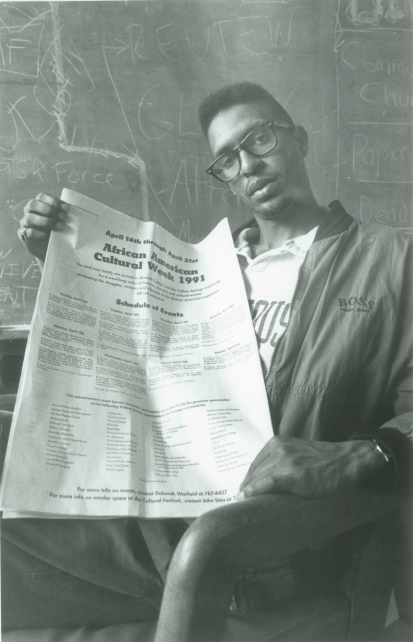
John Sims ’90 in 1991 as Special Assistant to the Dean of Faculty with an ad for the first African American Culture Week in the Yellow Springs News
During high school in Detroit, Sims “ran with the local socialists” and co-founded the student group SAW (Students Against War). Antioch College was a perfect fit for someone who wanted to study mathematics and who refused to play sports for socio-political reasons.
Reflecting on his time at Antioch, Sims explains, “The student radicalization and community governance on campus taught the power of communication and expression.” He learned “half the battle is to have a clear and dimensional expression of the issues and not to be afraid to challenge the institutions that breed contempt for change.”
He became very politically active while he was an exchange student at the University of Tübingen, Germany. “I helped start the first Afro-Student Union in Tübingen and was there in Berlin when the wall came down in 1989.”
Many Antiochians were influential in shaping Sims’ work. Dr. William “Bill” Houston, Antioch Professor Emeritus Of Mathematics was one. “Bill Houston was my main role model. His mathematics, his activism, his love of nature, his minimalism, his clarity of mind, and just was otherworldly.” Another mentor was music professor William David “Bill” Chappelle ’80. “His incredible emotional intelligence, the gift of language—both oral and written—were so inspirational.” Sims feels they “embodied the brilliance of the best of an Antioch experience.”
A year after graduating, Sims returned to work at the College as Special Assistant to the Dean of Faculty. During this time, he created and organized the Cross-Cultural Field Program (CCFP) that took a diverse group of students to the South to learn about African American culture. The program received strong support from both Coretta Scott King ’51 and Congressman John Lewis. He also founded African American Culture Week (AACW)—program events celebrating the African American experience which became the 25-year-running AACW Blues and Gospel Fest.
Sims has been on the forefront of contemporary mathematical art and leading the national pushback on Confederate iconography for 20 years. By combining his mathematics training with art, Sims seeks to confront symbols that represent white supremacy and to promote cross-cultural community.
His multimedia project Recoloration Proclamation (launched in 2000 and concluding with a series of shows starting at the Buffalo Arts Studios in March), is just one example of how Sims’ work has confronted racism in a very public way.
The project began in 2002 with a show in Harlem which featured various re-colored Iraqi, Chinese, Israeli, Palestinian and Confederate flags. But Sims found the reaction among attendees at the show’s opening to be typical—it didn’t provoke. Outside, however, a man had become outraged by the display of the Confederate flags. Intrigued by his response, Sims decided to dig deeper.
The next iteration he conceived was an installation piece—a “hanging” of the Confederate flag—at Gettysburg College in 2004. In the face of hate mail and death threats, he fought for the project to continue. But the organizers succumbed to the pressure resulting in a diminished, short-lived gallery installation. Sims boycotted his own show. “This experience was so disappointing and revealed the complicated dynamics of liberal institutions that teach one thing and do another,” Sims reflects.
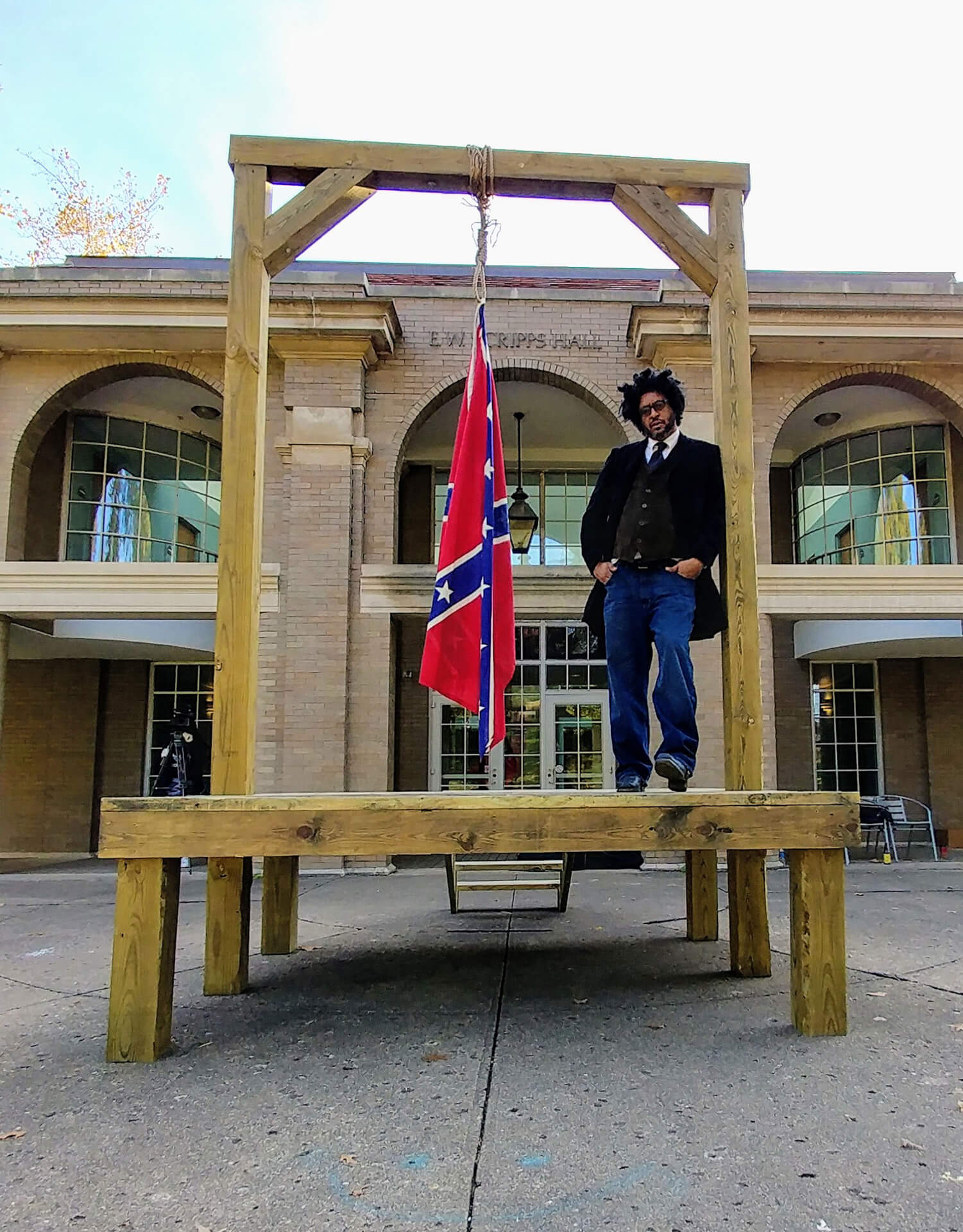
Sims 2017 installation, The Proper Way to Hang a Confederate Flag, at Ohio University’s Kennedy Museum
But the project landed squarely in the middle of a national political conversation about freedom of speech. He has continued with various iterations of his Recoloration Proclamation and, in 2015, held the now annual Burn and Bury Confederate Flag Memorial Day event—a long overdue funeral. In 2017, Sims successfully carried out his performance and exhibition of The Proper Way to Hang a Confederate Flag at Ohio University’s Kennedy Museum. In an interview with the Sarasota Herald Tribune Sims said, “It’s not just a conversation, but a forceful call to action leading to a movement to take down Confederate monuments across the South, and change school and street names honoring the Confederacy.” Sims says the Confederate flag represents fear, and this work is meant as a “confrontation of the fear through creative resistance.”
Sims’ work is featured as the subject of the first chapter of Stephen Ornes’ 2019 book, Math Art: Beauty, Truth, and Equations. And his project, The SquareRoot of Love—which Sims says “is about building community which I learned how to do at Antioch”—has been traveling to cities around the globe since 2010, “engaging the ideas of love through art, poetry, performance, food, and drink.”
Reflecting on the current climate, Sims says,“Race is hard to talk about because it is rooted in white supremacy, privilege, and power. Real power wants to be invisible and to make it visible is hard and uncomfortable. Real powerlessness wants to hide, but things are changing and things will continue to change. As long as the youth and students with an Antioch-like mindset push the conversation—the language, the expression, and actions for change—we might have a chance to push things forward.”
Learn more about John Sims’ work: johnsimsprojects.com

Published in Fall 2019/Winter 2020 issue of The Antiochian, a magazine for alumni and friends of Antioch College.

